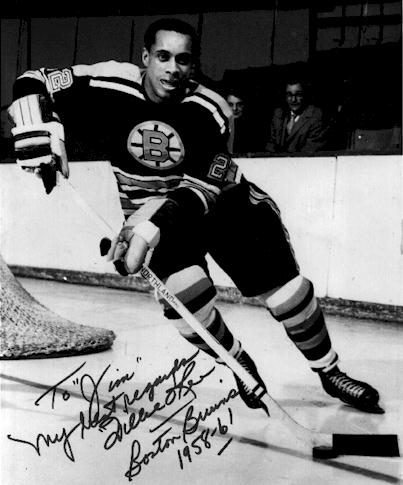Willie O'Ree Breaks NHL Colour-line
In 1958, eleven years after Jackie Robinson first played for the Dodgers, the Boston Bruins signed speedy forward Willie O'Ree.

Hockey has no black heroes
(c) 1996 Copyright Nando.net
1996 Scripps Howard
By Howard Richman
Kansas City Star
(Oct 19, 1996 - 10:13 EST) -- Hockey is still searching for a black hero.
A diversity-minded National Hockey League waits with open arms. It wants a player with an aura like golfer Tiger Woods. It wants to introduce more blacks to the game and more minorities in general. Yet the track record for numbers of blacks in professional hockey is far from overwhelming. Currently, there are 41 black players in the six major hockey leagues. That covers 106 franchises.
"A kid is going to emerge who is the Michael Jordan of hockey," said Bryant McBride, head of the NHL diversity task force. "Hockey is the most diverse of the four major sports. Nobody else can boast that it has players from 17 different countries.
"But there hasn't been that one black star who is amazing. It will happen."
The Kansas City Blades have two of those 41 black players. Dale Craigwell and Ian Boyce faced obstacles because of their skin color. They stayed the course. But many others didn't.
"A lot of my friends who were black played but dropped out because they couldn't handle the racism and the prejudice," Craigwell said. "A lot of people dropped out because people told them it's a white man's game. But I loved the game, and I wasn't dropping out for anything."
Boyce said: "I think we've broken the barrier and shown we can play hockey. Anybody is capable of playing hockey."
The first black hockey player in the professional ranks was the Boston Bruins' Willie O'Ree in 1958. After O'Ree, the NHL went years without black representation. Mike Marson of Washington followed O'Ree in 1974.
If there is a black hockey hero now, goaltender Grant Fuhr of the St. Louis Blues is as good a candidate as any. McBride, though, isn't so sure Fuhr fits the role.
"Behind that mask, many people didn't know that (he is black)," McBride said.
The NHL is doing its best to make the black community aware. And more involved. In conjunction with USA Hockey, the NHL lends its support to youth and junior programs from Albany, N.Y., to San Francisco. A program called "Ice Hockey in Harlem" began about 10 years ago, and its goal was to take youths off the street and teach them hockey. The NHL contributes equipment so youths only pay a small fee, or in some cases, nothing at all.
"The biggest hurdles with hockey are cost and ice time," McBride said. "We are trying to help break down both of those hurdles."
Kansas City, for example, lacks in black-youth hockey participation. Tom Prendergast, president of the Kansas City Junior Blades Amateur Hockey Association, said he knows of only one black youth that participates in the program. There are 500 youths ages 6 to 15 in the Junior Blades' organization. He said cost may keep some from playing. "Hockey parents spend about $400 per season," Prendergast said.
The growth of roller hockey and inline skating may help here and nationwide. A survey in 1988 determined that about 200,000 people did the roller-hockey and inline-skating thing. Now it's 25 million. And it could be growing. Nike is expected to market the Rollerblade soon.
"Getting more people to skate is great," said Akil Adams, a defenseman for Port Huron, Mich., of the Colonial Hockey League, "but we need to get more blacks in the sport, and that needs to be changed by people like me. When I go back to where I played growing up in Detroit, at the Jack Adams Community Center, the kids love it. But they don't think it's possible to make it out of there because I'm the only one that made it."
Black youths will have role models to select in the near future:
-- Mike Grier, Edmonton Oilers: Grier, a right winger, is fresh out of Boston University. Experts say he'll be the first black hockey star born and trained in the United States.
-- Anson Carter, Washington Capitals: Carter, a center, was sent down to Portland, Maine, of the American Hockey League. But expect him to be back soon and make an impact. (note: Anson Carter has since been traded to the Boston Bruins where he centres the second line and has been referred to as one of the two future stars of the team, along with #1 draft pick Joe Thornton).
Grier and Carter need to be the Tiger Woods of hockey. Otherwise it could be a long wait for such a figure.
"We scour all of North America," Princeton assistant coach Len Quesnelle said, "and I can count on one hand the number of black players I've seen over the last nine years."
Adams said Carter should be in the NHL right now. He wonders whether black hockey players ever will get a fair shot. But according to the NHL, minorities are getting a look. Forty-five percent of the teams have players under contract who are minorities. That compares with just 8 percent in 1990.
Adams still isn't convinced.
"Anson (Carter) is ready for the NHL," Adams said. "I'm not one to point fingers, but whether you like it or not, we (black players) are under a microscope. And I think there's people looking for us to fail. Not everybody. There are those who have an interest in us. But I can't believe Anson has to go out and be unbelievable to get his shot at the show."
Blades vice president/general manager Doug Soetaert doubts anybody wants to hold blacks back.
"If a kid can play, I don't care what color he is," Soetaert said.


Check out:
Some Current Players, A Little History,
The Black Aces, The Suspensions,
Guestbook,
or send me some mail



